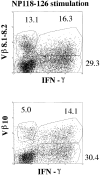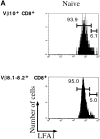Conserved T cell receptor repertoire in primary and memory CD8 T cell responses to an acute viral infection
- PMID: 9653085
- PMCID: PMC2525546
- DOI: 10.1084/jem.188.1.71
Conserved T cell receptor repertoire in primary and memory CD8 T cell responses to an acute viral infection
Abstract
Viral infections often induce potent CD8 T cell responses that play a key role in antiviral immunity. After viral clearance, the vast majority of the expanded CD8 T cells undergo apoptosis, leaving behind a stable number of memory cells. The relationship between the CD8 T cells that clear the acute viral infection and the long-lived CD8 memory pool remaining in the individual is not fully understood. To address this issue, we examined the T cell receptor (TCR) repertoire of virus-specific CD8 T cells in the mouse model of infection with lymphocytic choriomeningitis virus (LCMV) using three approaches: (a) in vivo quantitative TCR beta chain V segment and complementarity determining region 3 (CDR3) length repertoire analysis by spectratyping (immunoscope); (b) identification of LCMV-specific CD8 T cells with MHC class I tetramers containing viral peptide and costaining with TCR Vbeta-specific antibodies; and (c) functional TCR fingerprinting based on recognition of variant peptides. We compared the repertoire of CD8 T cells responding to acute primary and secondary LCMV infections, together with that of virus-specific memory T cells in immune mice. Our analysis showed that CD8 T cells from several Vbeta families participated in the anti-LCMV response directed to the dominant cytotoxic T lymphocyte (CTL) epitope (NP118-126). However, the bulk (approximately 70%) of this CTL response was due to three privileged T cell populations systematically expanding during LCMV infection. Approximately 30% of the response consisted of Vbeta10+ CD8 T cells with a beta chain CDR3 length of nine amino acids, and 40% consisted of Vbeta8.1+ (beta CDR3 = eight amino acids) and Vbeta8.2+ cells (beta CDR3 = six amino acids). Finally, we showed that the TCR repertoire of the primary antiviral CD8 T cell response was similar both structurally and functionally to that of the memory pool and the secondary CD8 T cell effectors. These results suggest a stochastic selection of memory cells from the pool of CD8 T cells activated during primary infection.
Figures


















Similar articles
-
Evolution of the T cell repertoire during primary, memory, and recall responses to viral infection.J Immunol. 2000 Dec 1;165(11):6081-90. doi: 10.4049/jimmunol.165.11.6081. J Immunol. 2000. PMID: 11086040
-
Stability and diversity of T cell receptor repertoire usage during lymphocytic choriomeningitis virus infection of mice.J Exp Med. 1998 Dec 7;188(11):1993-2005. doi: 10.1084/jem.188.11.1993. J Exp Med. 1998. PMID: 9841914 Free PMC article.
-
T Cell Receptor Diversity and Lineage Relationship between Virus-Specific CD8 T Cell Subsets during Chronic Lymphocytic Choriomeningitis Virus Infection.J Virol. 2020 Sep 29;94(20):e00935-20. doi: 10.1128/JVI.00935-20. Print 2020 Sep 29. J Virol. 2020. PMID: 32759317 Free PMC article.
-
Tracking phenotypically and functionally distinct T cell subsets via T cell repertoire diversity.Mol Immunol. 2008 Feb;45(3):607-18. doi: 10.1016/j.molimm.2006.05.017. Epub 2007 Aug 24. Mol Immunol. 2008. PMID: 17719639 Free PMC article. Review.
-
The great balancing act: regulation and fate of antiviral T-cell interactions.Immunol Rev. 2013 Sep;255(1):110-24. doi: 10.1111/imr.12093. Immunol Rev. 2013. PMID: 23947351 Free PMC article. Review.
Cited by
-
How age and infection history shape the antigen-specific CD8+ T-cell repertoire: Implications for vaccination strategies in older adults.Aging Cell. 2020 Nov;19(11):e13262. doi: 10.1111/acel.13262. Epub 2020 Oct 20. Aging Cell. 2020. PMID: 33078890 Free PMC article. Review.
-
A public T cell clonotype within a heterogeneous autoreactive repertoire is dominant in driving EAE.J Clin Invest. 2007 Aug;117(8):2176-85. doi: 10.1172/JCI28277. J Clin Invest. 2007. PMID: 17627303 Free PMC article.
-
Natural killer T cells reactive to a single glycolipid exhibit a highly diverse T cell receptor beta repertoire and small clone size.Proc Natl Acad Sci U S A. 2001 Oct 23;98(22):12636-41. doi: 10.1073/pnas.221445298. Epub 2001 Oct 9. Proc Natl Acad Sci U S A. 2001. PMID: 11592984 Free PMC article.
-
Immunization of volunteers with Salmonella enterica serovar Typhi strain Ty21a elicits the oligoclonal expansion of CD8+ T cells with predominant Vbeta repertoires.Infect Immun. 2005 Jun;73(6):3521-30. doi: 10.1128/IAI.73.6.3521-3530.2005. Infect Immun. 2005. PMID: 15908381 Free PMC article.
-
Distinct time effects of vaccination on long-term proliferative and IFN-gamma-producing T cell memory to smallpox in humans.J Exp Med. 2004 Jun 7;199(11):1585-93. doi: 10.1084/jem.20032083. J Exp Med. 2004. PMID: 15184506 Free PMC article.
References
-
- Ahmed R, Gray D. Immunological memory and protective immunity: understanding their relation. Science. 1996;272:54–60. - PubMed
-
- Wilson RK, Lai E, Concannon P, Barth RK, Hood LE. Structure, organization and polymorphism of murine and human T-cell receptor alpha and beta chain gene families. Immunol Rev. 1988;101:149–172. - PubMed
-
- Davis MM. T cell receptor gene diversity and selection. Annu Rev Biochem. 1990;59:475–496. - PubMed
-
- Goverman J, Minard K, Shastri N, Hunkapiller T, Hansburg D, Sercarz E, Hood L. Rearranged beta T cell receptor genes in a helper T cell clone specific for lysozyme: no correlation between V beta and MHC restriction. Cell. 1985;40:859–867. - PubMed
-
- Goverman J, Hunkapiller T, Hood L. A speculative view of the multicomponent nature of T cell antigen recognition. Cell. 1986;45:475–484. - PubMed
Publication types
MeSH terms
Substances
Grants and funding
LinkOut - more resources
Full Text Sources
Other Literature Sources
Molecular Biology Databases
Research Materials

